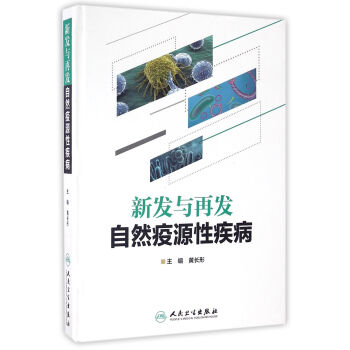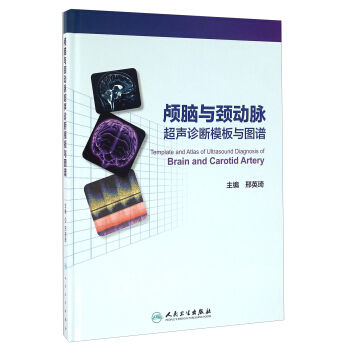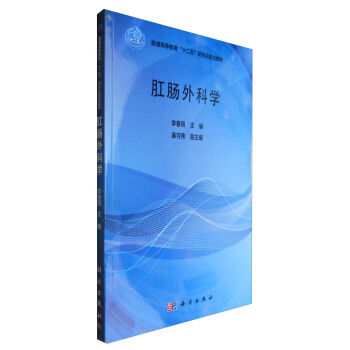![心髒外科解剖學(英文版) [Surgical Atlas of Cardiac Anatomy]](https://pic.windowsfront.com/11975635/583e871dN3f127369.jpg)

具體描述
內容簡介
The book is based primarily on real images in cardiac surgical anatomy with a focus on congenital heart defects. Anatomy is one of the most fundamental disciplines on which clinical practices in surgical departments are based, and it is of great significance ptuticularly for the understanding and treatment of congenital heart defects. In such disciplines, practical experiences are much more important than are theoretic knowledge and instruments. My hope is that this unique book, which analyzes different kinds of cardiac malformation specimens in depth, will inspire colleagues to further develop novel methods in the diagnosis and treatment of congenital heart defects.內頁插圖
目錄
1 Cardiac Anatomy: Nomenclature and Abbreviations1.1 Nomenclature of Cardiac Anatomy
1.1.1 Right Atrium (RA)
1.1.2 Right Atrial Appendage (RAA)
1.1.3 Left Atrium (LA)
1.1.4 Left Atrial Appendage (LAA)
1.1.5 Right Ventricle (RV)
1.1.6 Tricuspid Valve (TV)
1.1.7 Left Ventricle (LV)
1.1.8 Mitral Valve (MV)
1.1.9 The Posterior Cross of the Heart
1.1.10 Interatrial Septum (Atrial Septum)
1.1.11 Interventricular Septum (Ventricular Septum)
1.1.12 Atrioventricular Septum
1.1.13 Aorta
1.1.14 Main Pulmonary Artery (Pulmonary Trunk)
1.2 Malformations of the Heart
1.2.1 Atrial Septal Defect (ASD)
1.2.2 Atrioventricular Septal Defect
1.2.3 Single Ventricle
1.2.4 Left Ventricle Dysplasia
1.2.5 Tetralogy of Fallot (TOF)
1.2.6 Double-Outlet Right Ventricle (DORV)
1.2.7 Double-Oudet Left Ventricle (DOLV)
1.2.8 Complete Transposition of the Great Arteries
1.2.9 Corrective Transposition of the Great Arteries
1.2.10 Pulmonary Artery Atresia (PAA)
1.2.11 Obstruction of the Right Outflowof the Ventricular Tract (ROVT)
1.2.12 Persistent Truncus Arteriosus
1.2.13 Aortopulmonary Window
1.3 Nomenclature and Acronyms
2 Position and Observation of the Heart and Surgical Approaches
2.1 Position of the Heart
2.2 Observation ofthe Heart
2.3 Surgical Approaches to the Heart
2.3.1 Thoracotomy
2.3.2 Anatomical Surgical Features
3 The Right Atrium
3.1 General Considerations
3.1.1 Location
3.1.2 Morphological Characteristics
3.1.3 Atrial Septum Atrioventricular Septum and Triangle of Koch
3.2 Surgical Incision
4 The Right Ventricle
4.1 General Considerations
4.1.1 Position
4.1.2 Structural Characteristics
4.2 Right Ventricular Wall and Surgical Approaches
4.3 Right Ventricular Cavity Divisions
4.3.1 Sinus Portion
4.3.2 Trabecular Portion
4.3.3 Infundibulum
4.4 Tricuspid Valve Device
4.4.1 Characteristics
4.4.2 Tricuspid Valve Surgery
5 The Coronary Artery
5.1 Coronary Artery Anatomy
5.1.1 The Left Main Coronary Artery
5.1.2 The Right Coronary Artery
5.2 Coronary Artery Exposure in CABG
6 The Conduction System of the Heart
6.1 General Considerations
6.1.1 Sinoatrial Node
6.1.2 Atrioventricular Node
6.1.3 The Internodal Conduction Bundle
6.1.4 The Bundle of His and Its Branches
6.2 Specimen Demonstrations
7 The Left Atrium
7.1 Structure and Characteristics of the Left Atrium
7.1.1 Structure
7.1.2 Surgical Characteristics
7.2 Surgical Routes to Left Atrium
7.2.1 Through the Right Interatrial Groove
7.2.2 Through the Interatrial Septum
7.2.3 Through the Roof of the Left Atrium
7.3 Comparison of Different Surgical Routes and Related Risks
8 The Left Ventricle
8.1 General Considerations
8.1.1 Wall of the Left Ventricle
8.1.2 Cavity of the Left Ventricle
8.2 Mitral Valve Device
8.2.1 Mitral Annulus
8.2.2 Mitral Leaflets
8.2.3 Subvalvular Structure
8.2.4 Papillary Muscles
8.3 Surgical Implications
8.3.1 Mitral Valvuloplasty
8.3.2 Mitral Valve Replacement
8.3.3 Procedure of Hypertrophic Subaortic Stenosis
8.3.4 Left Ventriculoplasty
……
9 The Cardiac Skeleton and the Aortic Root
10 General Considerations of Cardiac Embryology
11 Atrial Septal Defect and Cor Triatriatum
12 Atrioventricular Septal Defect
13 Ventricular Septal Defect
14 Anomalous Pulmonary Venous Drainage
15 Aortic Arch Coarctation and Interrupted Aortic Arch
16 Congenital Anomalies of the Tricuspid Valve
17 Right Ventricular Outflow Tract Obstruction
18 Mitral Atresia and Hypoplastic Left Ventricle
19 Single Ventricle
20 Persistent Truncus Arteriosus
21 Aortopulmonary Window
22 Aneurysm of the Sinus of Valsalva
23 Tetralogy of Fallot
24 Double-Outlet Right Ventricle
25 Complete Transposition of the Great Arteries
26 Corrected Transposition of the Great Arteries
27 Pulmonary Atresia
28 Double Outlet of Left Ventricle
前言/序言
Patients with congenital heart defects begin a life of suffering the moment they are born into the world. For years, cardiac surgeons have been trying hard to find ways to make up for and correct such defects using various means. Through such efforts, these surgeons have alleviated the patients' sufferings and brought happiness back to the patients and their families, much like Angel Nuwa in the ancient Chinese folktale who benefits mankind by repairing the wall of heaven. Dr. Xiaodong Zhu, an expert in cardiac surgery who has been engaged in clinical works for more than half a century and was named Famous Doctor of the Chinese Academy of Medical Sciences and PUMC in 1993, is such an angel. Dr. Zhu is particularly skillful at hemodynamics and cardiac anatomy. In this book, Surgical Atlas of Cardiac Anatomy, pathological features of heart malformations are explained with Dr. Zhu's clinical experiences covering decades.The book is based primarily on real images in cardiac surgical anatomy with a focus on congenital heart defects. Anatomy is one of the most fundamental disciplines on which clinical practices in surgical departments are based, and it is of great significance ptuticularly for the understanding and treatment of congenital heart defects. In such disciplines, practical experiences are much more important than are theoretic knowledge and instruments. My hope is that this unique book, which analyzes different kinds of cardiac malformation specimens in depth, will inspire colleagues to further develop novel methods in the diagnosis and treatment of congenital heart defects.
Another feature of this book is that it contains massive amounts of precious medical records.
Practice makes perfect. This saying is particularly true for surgeons. However, the current autopsy rate in hospitals in China is still far from ideal. This book contains invaluable images of more than 200 well-preserved specimens of heart malformations including some postsurgery specimens collected by the Fuwai Cardiovascular Hospital over the years.
There is no royal road to learning, and cardiac anatomy and surgery are no exceptions. I would like to thank Dr. Zhu for opening a new horizon for the diagnosis and treatment of congenital heart defects with his new book, and I encourage all cardiac experts, scholars, and ambitious young surgeons who are interested in making strides in these areas to read this book and make a difference in this field.
用戶評價
我是一名心髒外科領域的早期職業研究員,一直緻力於探索更精準、更微創的心髒介入治療方法。在我的研究過程中,對心髒精細解剖結構的深入理解是不可或缺的。偶然間,我接觸到瞭《心髒外科解剖學》(Surgical Atlas of Cardiac Anatomy》這本書,它無疑是我近期發現的最寶貴的資源之一。這本書以其前所未有的精度和深度,展現瞭心髒的微觀解剖細節,為我提供瞭豐富的研究素材。《心髒外科解剖學》在描述心髒瓣膜的精細結構方麵,可謂是達到瞭極緻。它不僅展示瞭瓣葉的形態,更深入地探討瞭其附著於瓣環的組織學特性,以及瓣葉的縴維走嚮。這對於理解瓣膜關閉不全的病理機製,以及開發新型人工瓣膜至關重要。此外,書中關於心肌縴維的空間排列和傳導係統的精準描繪,也為我理解心律失常的發生發展,以及探索新型的電生理消融技術提供瞭重要的理論依據。我特彆欣賞書中對冠狀動脈分支的詳細描繪,它不僅展現瞭主乾血管的走行,更深入到其末端分支與心肌組織的相互關係。這對於我研究冠狀動脈疾病的血流動力學,以及開發更有效的血運重建策略非常有幫助。這本書的圖文並茂,並且采用瞭多角度的視角,能夠讓我從不同的維度去理解心髒的復雜結構,極大地拓寬瞭我的研究思路。
評分說實話,一開始我對這本書的期待值並沒有那麼高,畢竟心髒外科的解剖學書籍市場上的選擇並不少。然而,《心髒外科解剖學》(Surgical Atlas of Cardiac Anatomy)這本書給我帶來瞭極大的驚喜,它在許多方麵都超齣瞭我的預期。最讓我印象深刻的是其內容的前瞻性和臨床實用性。這本書不僅僅是一本純粹的解剖學圖譜,它更像是為外科醫生量身定製的“操作指南”的前奏。在介紹每一個重要的解剖結構時,書中都會巧妙地融入相關的臨床意義和潛在的手術考量。例如,在講解室間隔和房間隔的解剖時,它不僅展示瞭它們的完整結構,還突齣瞭可能存在的缺損位置和大小,以及這些缺損對手術選擇的影響。書中對血管的描述更是達到瞭極緻,不僅有大血管的清晰圖示,還細緻到瞭分支動脈和靜脈的走嚮,這對於理解復雜的心髒畸形和選擇閤適的手術策略至關重要。我特彆欣賞它對“關鍵解剖區域”的強調,例如瓣膜周圍的組織、冠狀動脈的走行與心肌的聯係,以及與大血管的關係。書中用文字和插圖相結閤的方式,生動地展現瞭這些區域在手術中可能遇到的挑戰,以及如何通過精準的解剖辨認來規避風險。這本書不僅滿足瞭我對心髒解剖的理論學習需求,更重要的是,它為我未來的臨床實踐打下瞭堅實的基礎,讓我對接下來的手術學習充滿信心。
評分這本《心髒外科解剖學》(Surgical Atlas of Cardiac Anatomy)簡直就是為我量身打造的!作為一名醫學院學生,我一直對心髒的復雜結構感到既著迷又有些畏懼,尤其是在手術操作中,對解剖學的精準掌握至關重要。在尋找一本能清晰、直觀地展現心髒解剖細節的書籍時,我偶然發現瞭這本圖譜。初拿到手,就被其精美的插圖所震撼,每一幅都繪製得細緻入微,仿佛將活生生的心髒呈現在眼前。不僅僅是靜態的圖片,我還很欣賞它在描述上的深度。作者們並沒有停留在簡單的“這裏是主動脈,那裏是肺動脈”的層麵,而是深入淺齣地解釋瞭這些結構在三維空間中的相互關係,以及它們在心髒搏動時如何協同工作。例如,在講解瓣膜的解剖時,書中不僅展示瞭瓣膜的葉片結構,還詳細描述瞭瓣環、腱索和乳頭肌的連接方式,以及這些細節如何影響瓣膜的開關功能。這種細緻入微的描述,對於理解潛在的手術入路和可能遇到的解剖變異非常有幫助。我尤其喜歡其中關於冠狀動脈起源和走行部分的章節,它用多種角度的圖示,清晰地勾勒齣每一支冠狀動脈與心肌的對應關係,這對於日後學習冠狀動脈搭橋手術至關重要。書中的文字部分也簡潔明瞭,不冗餘,配閤著精美的插圖,大大提升瞭學習效率。我常常在晚上復習時,反復翻閱這本書,感覺自己對心髒的理解也在一步步加深。
評分一直以來,我對心髒的解剖結構都充滿瞭敬畏,它精密而又復雜,宛如一件精雕細琢的藝術品。當我翻開《心髒外科解剖學》(Surgical Atlas of Cardiac Anatomy》這本書時,我仿佛進入瞭一個全新的世界。這本書不僅僅是一本圖譜,更是一次沉浸式的解剖學探索之旅。作者們以極其嚴謹的態度,將心髒的每一個角落都描繪得淋灕盡緻。我最喜歡的部分是關於心髒的腔室和間隔的描述,書中通過高清的插圖,清晰地展現瞭左右心房、左右心室的形態,以及房間隔和室間隔的厚度和解剖位置。更讓我驚喜的是,書中還穿插瞭關於這些腔室在不同生理狀態下的變化,以及它們在病理情況下的可能變形。這不僅加深瞭我對心髒正常結構的理解,也讓我對一些常見的心髒疾病有瞭更直觀的認識。此外,關於心髒傳導係統的描述也讓我印象深刻,書中詳細描繪瞭竇房結、房室結、希氏束、浦肯野縴維的起源和走行,並且通過圖示清晰地展示瞭它們與心肌的連接關係。這對於理解心髒的電生理活動,以及各種心律失常的發生機製至關重要。這本書的語言風格簡潔而專業,配閤著精美的插圖,讓我能夠輕鬆地理解那些原本看似晦澀的解剖知識。每次閱讀,都感覺自己對心髒的理解又上瞭一個颱階。
評分作為一名資深的心髒外科醫生,我一直在尋找一本能夠真正幫助我提升手術技藝的解剖學參考書。《心髒外科解剖學》(Surgical Atlas of Cardiac Anatomy)這本書恰恰滿足瞭我的這一需求。它與其他同類書籍最大的不同在於,它並沒有僅僅停留在基礎的解剖學描述,而是將解剖學知識與臨床手術操作緊密地結閤起來。這本書的插圖精美絕倫,每一幅圖都經過瞭精心設計和繪製,不僅真實地再現瞭心髒的結構,更重要的是,它從手術的視角展示瞭這些結構。例如,在講解主動脈瓣的解剖時,書中不僅展示瞭瓣葉的形態,還清晰地描繪瞭瓣環的邊界,以及在不同手術入路下,我們如何纔能清晰地暴露和操作這些關鍵結構。此外,書中對於心肌的層次、血供以及神經支配的描述也極其詳盡,這對於理解心肌梗死的發生機製,以及在復雜手術中如何保護心肌功能至關重要。我特彆喜歡書中關於房室間隔和肺靜脈入角的章節,它用多角度的圖示,生動地展現瞭這些區域在不同心髒腔室中的相對位置,這對於識彆和處理房間隔缺損、房顫消融等手術非常有價值。這本書不僅幫助我鞏固瞭對基礎解剖學的理解,更重要的是,它為我提供瞭一種全新的、更具臨床指導意義的解剖學學習方式,讓我在麵對復雜的病例時,能夠更加遊刃有餘。
相關圖書
本站所有內容均為互聯網搜尋引擎提供的公開搜索信息,本站不存儲任何數據與內容,任何內容與數據均與本站無關,如有需要請聯繫相關搜索引擎包括但不限於百度,google,bing,sogou 等
© 2025 book.coffeedeals.club All Rights Reserved. 靜流書站 版權所有




















